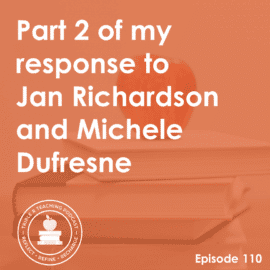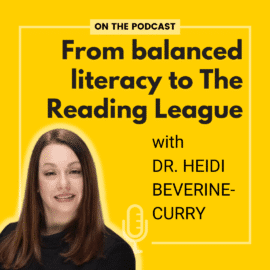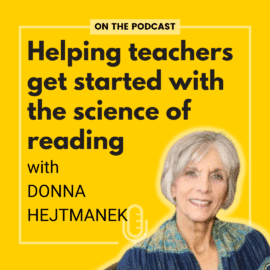
TRT Podcast #29: Answers to decodable book FAQ’s
Why should we use decodable books? Who should be reading them? For how long? Get answers to these questions and more in today’s episode!
Listen to the episode here
Full episode transcript
In today's episode, I'm going to answer common questions about decodable readers.
I've been upfront about this before, but I'll say it again, I wasn't always a fan of decodable readers. Decodable readers, also called decodable books, can be stilted, boring, and nonsensical. The good news is that times are changing! These days, it isn't hard to find beautiful, interesting, and meaningful decodable texts, even for very young readers.
So let's talk about decodable books.
What are they?
According to the Iowa Reading Research Center,
"Decodable readers are texts that introduce words and word structures in a carefully planned scope and sequence. The order in which that word structure is introduced often aligns with the scope and sequence of the curriculum. In this way, students have the opportunity to apply the phonics skills they are learning and to build confidence in their abilities to read full sentences and short stories."
It's really important to remember that a book is only decodable for a child if the child has been taught the sound spellings within the book, so what's decodable for one child is not necessarily decodable for another.
You might be wondering if a book has to be 100% decodable to qualify. It does not. In his book, Choosing and Using Decodable Texts, Wiley Blevins states this, "If one story is more comprehensible and engaging at 65% or 70% decodable than another story at 80% that has stilted sentences and odd language structures, I prefer the story with slightly lower decodability."
Why should we use decodable readers with our students?
For years I resisted them, not only did I believe that all of them were boring without any kind of meaningful story, but I thought I had a much better alternative. I used leveled books with my beginning readers. Early leveled books usually have predictable text and words that students can figure out using the picture and/or context. I thought I was teaching my students to be strategic readers by encouraging them to use all the cues available to them, meaning syntax and the visual cue of phonics.
It wasn't until I began exploring the science of reading that I realized that teaching kids to use three-cueing is counterproductive at best and harmful at worst.
It all comes down to how the brain learns to read. In the brain, there are different areas that work together to help us read. We need to get the phonological processor, which focuses on sounds, to connect with the orthographic processor, which focuses on print.
How do we get these areas to work together?
We give kids explicit, systematic phonics instruction and practice with decoding.
Where will they get that practice?
You guessed it, reading and re-reading quality decodable texts and books. When a child decodes a word enough times, it becomes orthographically mapped. That means they recognize it instantly without needing to sound it out or guess. It's not because they've memorized the word as a whole; it's because they've connected the letters to the sounds. Some kids can orthographically map a word after decoding it just a few times, others need more exposures to the word.
Who should be reading decodable books and for how long?
Well, decodable books are the "training wheels" of reading. According to Phonic Books, once children develop sufficient decoding skills to read authentic texts, they no longer need decodable texts. If they resort to guessing, this means they have insufficient decoding skills and need decodable books for a bit longer.
There's an excellent webinar that you can find on YouTube where Michael Hunter and Linda Farrell state that they feel kids are ready to move out of decodable books when they're at about a Level J. It's still up for debate about whether we even want to use the Fountas and Pinnell reading levels at all, right now I'm still waffling, but I think that they can be useful for kids once you're past those early levels, just to kind of get a general idea of where they're at. But Level J would be, for example, Frog and Toad - that's about a Level K. Poppleton, Henry and Mudge, those are Level J books. Basically Level J books are regular books, they're not written to be leveled books, they're just already in your library. So once kids are about in that space, they're probably ready to read authentic literature during their independent reading time. However, keep this in mind. Even though we can eventually guide our students toward non-decodable books for their independent reading practice, decodable text is still very valuable in our small group phonics lessons.
So how to use decodable texts?
I recommend teaching phonics in small groups because it's much easier to narrow in on exactly what the students are ready to learn. You know that if you're teaching anywhere at all, students come to you with a huge variety of reading skills. My first year of teaching first grade, I had a student who couldn't remember the letters of the alphabet after two years in kindergarten, and I had a couple kids who were reading at a fourth grade level. Teaching phonics to the whole group, which I was expected to do, was a fail. My sweet little student who couldn't remember letter sounds was very confused and those advanced readers were quite bored.
In my opinion, it's better to assess kids with a good phonics assessment and teach students in small groups. When you're using the decodable text, you'll first want to teach the new sound-spelling, read blending lines that give practice with the new concept, and introduce high frequency words that appear in the text. As your students are reading, you may want to read the book chorally, then have them whisper read it, give feedback as they read independently, and discuss the story. After reading, you're going to ask comprehension questions and you're going to provide opportunities for students to reread the text on future days.
As to where you can find quality decodable texts, maybe you've seen my Ultimate List of Decodable Books. I will link to that in the show notes for today's episode, and you can find those show notes at themeasuredmom.com/episode29.
Sign up to receive email updates
Enter your name and email address below and I'll send you periodic updates about the podcast.
Related links
- Free fiction decodable books
- Free nonfiction decodable books
- Ultimate guide to decodable book series







[…] post How to meet every writer’s needs during writing workshop appeared first on The Measured […]